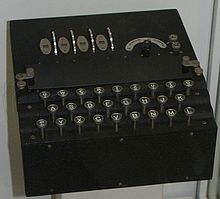Enigma-D
The Enigma-D (also: Enigma D or Enigma Model D ) is an early model of the Enigma rotor key machine .
history

In the long history of the different Enigma models , the Enigma-D, introduced in 1926, was the sixth model in chronological terms (see also: family tree of the Enigma under web links ). Like its direct predecessor, the Enigma-C , the Enigma-D was an "incandescent lamp machine", so it used incandescent lamps for output (and not type levers such as the so-called " trading machine " from 1923 and the " writing Enigma " from 1924). Compared to the Enigma-C, the Enigma-D showed a number of practical and cryptographic improvements. Keys and lamps were in the even then for typewriters and today for keyboards usual qwertzu assignment arranged. With the exception of the previous model C and the later Enigma-Z , all Enigma models had this arrangement for buttons and lamps:
Q W E R T Z U I O
A S D F G H J K
P Y X C V B N M L
The reverse roller (VHF) , which was still permanently installed in the C model, could be manually set to one of 26 different positions (A – Z) on the Enigma D, similar to its three rotating rollers. The VHF was “settable”, but did not rotate with the key process. The rotating rollers were now on a removable axle. This made it possible to change the “roller position” , i.e. the order of the three rotating rollers within the roller set, in a simple manner. With three rolls there were now 3 · 2 · 1 = 6 possible different roll positions. All of this increased the combinatorial complexity of the machine and strengthened the encryption . The key space of the Enigma-D results from the product of the 6 roller layers and the 26 4 different roller positions (for VHF and the three rotating rollers) to 6 × 456,976 = 2,741,856 or about 21 bits . The exact wiring of the rollers is given in the Roller Wiring chapter of the article on the Enigma rollers .
The Enigma-D served Japanese cryptographers as a model for an Enigma replica ( San-shiki Kaejiki ) developed in Japan . In 1939 the production of the Enigma-D was stopped.
literature
- Friedrich L. Bauer : Deciphered Secrets. Methods and maxims of cryptology. 3rd, revised and expanded edition. Springer, Berlin a. a. 2000, ISBN 3-540-67931-6 .
- Friedrich L. Bauer: Historical Notes on Computer Science . Springer, Berlin 2009, ISBN 3-540-85789-3 .
- Louis Kruh, Cipher Deavours: The Commercial Enigma - Beginnings of Machine Cryptography . (PDF; 0.8 MB) In: Cryptologia , Vol. 26 (1), January 2002, p. 1.
- Heinz Ulbricht: The Enigma cipher machine - deceptive security. A contribution to the history of the intelligence services . (PDF; 4.7 MB) Dissertation, Braunschweig 2005
Web links
- Enigma-D in the Crypto Museum (English); Retrieved March 3, 2016.
- Enigma Family Tree Family tree of the Enigma (English); Retrieved March 3, 2016.
- Photo of an Enigma-D in the Crypto Museum ; Retrieved March 3, 2016.
Individual evidence
- ↑ Louis Kruh, Cipher Deavours: The commercial Enigma - Beginnings of machine cryptography . (PDF; 0.8 MB) In: Cryptologia , Rose-Hulman Institute of Technology, Taylor & Francis, Philadelphia PA 26.2002,1 (January), p. 7, ISSN 0161-1194, accessed on March 3, 2016.
- ↑ Friedrich L. Bauer: Deciphered secrets. Methods and maxims of cryptology. 3rd, revised and expanded edition. Springer, Berlin a. a. 2000, p. 147.
- ↑ David H. Hamer, Geoff Sullivan, Frode Weierud: Enigma Variations - An Extended Family of Machines . Cryptologia. Rose-Hulman Institute of Technology. Taylor & Francis, Philadelphia PA 22.1998, 1 (July), p. 219, ISSN 0161-1194 . cryptocellar.org (PDF; 80 kB), accessed December 18, 2018.
